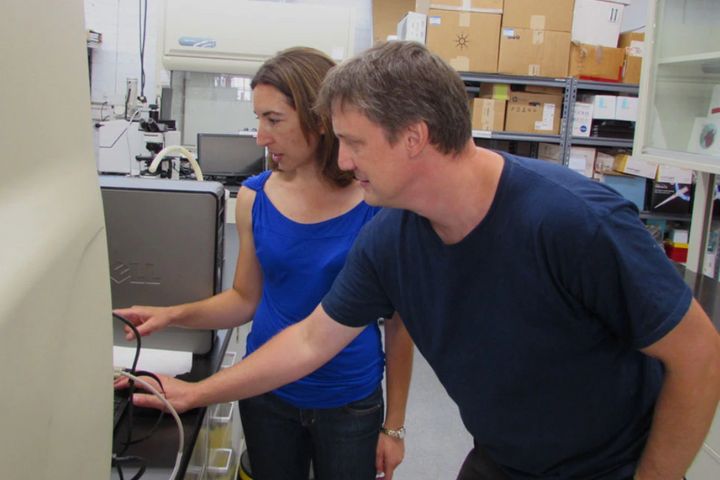By Leily Sanchez, Cal State LA News Service
Two scientists who graduated from the Cal State LA BioStart program have received a nearly $300,000 grant from the National Institutes of Health (NIH) to use in preclinical studies to test their drug-delivery system in a mouse model of pancreatic cancer.
Gayle Boxx and Jan Mrazek, the founders of Aukera Inc. of Pasadena, were part of the first cohort of Cal State LA BioStart, a five-week program for bioscience entrepreneurs, in 2017. Cal State LA BioStart provides startup companies with training, mentoring and business knowledge essential to creating and sustaining bioscience ventures.
“While we had already formed our company and had covered much of the corporate setup, it was great to learn about the different aspects of regulation, of moving products forward,” Boxx says. Topics covered in the program include business fundamentals, financing models, industrial research and development, regulatory affairs, quality systems, clinical trials, leadership skills and communication strategies.
“I think it was instrumental to our success,” Boxx says of her experiences in Cal State LA BioStart.
The program is part of a broader initiative called Cal State LA BioSpace, an effort of the University with partners from government, academia, private industry and the nonprofit sector to promote a thriving bioscience ecosystem in the heart of Los Angeles. Cal State BioSpace provides emerging entrepreneurs with facilities, resources, training and knowledge to launch startup ventures and spur regional economic development at no cost to eligible participants.
Boxx and Mrazek believe that their product, called the nCap, is the next advancement for the delivery of vaccines or other therapeutic molecules to treat illnesses including cancer. The nCap is modeled after the vault nanoparticle, a cellular structure that occurs organically in the body.
“What we will do is use our nCap platform to encapsulate a vaccine that will target the immune system to attack the cancer cells,” Boxx says. “So our technology uses the vault nanocapsule, which is naturally present in the body, so it makes an ideal delivery vehicle.”
A nanoparticle is a microscopic particle with dimensions less than 100 nanometers. The nCap nanoparticle, which is manufactured at Aukera Inc., is 67 nanometers long. A strand of hair is 100,000 nanometers wide.
Vaults are large intracellular particles composed of protein and ribonucleic acid (RNA), the genetic messenger present in all living cells. Since the discovery of vaults in 1986 at UCLA, their cellular functions are still unclear. However, Boxx and Mrazek say that because of the barrel-shaped structure, properties and composition, vaults can be used to encapsulate and transport therapeutic molecules to targeted cells.
Unlike existing treatments, the nCap, given its stability, can be shipped and stored at room temperature in a liquid form, Boxx and Mrazek explain. That cuts the time the clinician needs to reconstitute and to administer the drug, reducing variability in the drug’s efficacy. This quality eliminates the need for a refrigeration system, which is lacking in some countries.
Because the vault nanoparticle is already present in the body, Mrazek says, it does not generate an unwanted immune response and will degrade naturally without side effects. The vault nanocapsule’s large interior allows for the packaging of different types of molecules, and the technology does not require chemical modification of the cargo.
For example, chemotherapy is the primary treatment for cancer. However, many anticancer drugs do not easily dissolve in water, making chemotherapy problematic because the human body is largely composed of water. This means that the drugs are difficult to administer intravenously without the use of complicated organic solvents that are highly toxic and cause severe side effects.
“Really, it is something that the [pharmaceutical] industry has been struggling with for years,” Mrazek says. “… Some particles maybe had good cargo capacity but were more toxic. Or some less toxic but you couldn’t put enough cargo inside. Or they were immunogenic, or they were unstable, or they were not biodegradable. … Why reinvent the wheel? We want to take something that nature already discovered or made.”
Boxx and Mrazek have high hopes for their research. The funding they received from the NIH’s Phase I Small Business Innovation Research program is for one year. They anticipate applying for Phase II of the program to further demonstrate technical merit and feasibility before commercialization and seeking potential partners.
As for the future of Aukera and the nCap vault nanoparticle, if the research and development phase results go as expected, Mrazek says: “We are open to any company that wants to collaborate or deliver their product using our vault platform. We are open to anybody. You have a drug, you give it to us, and we encapsulate it and give it to you. … And if there is some positive effect, we have an amazing thing.”
